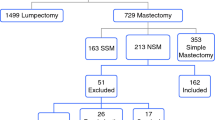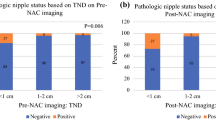Abstract
Purpose
To assess the oncological safety of nipple–areola complex (NAC) sparing mastectomy in breast cancer patients.
Methods
From 2010 to 2015, 518 breast cancer patients were submitted to NAC sparing mastectomy. Breast MRI and intraoperative assessment of the subareolar (SD) and proximal (ND) nipple ducts were performed to predict NAC involvement. Significant associations between pre- and postoperative variables with SD/ND involvement and with the risk of local recurrence were retrospectively investigated.
Results
SD/ND were involved in 26.1% of the cases. Final pathology of SD/ND was predicted by tumor–NAC distance at MRI and intraoperative pathology with 75 and 93% accuracy, respectively. NAC involvement was more frequent in case of positive ND than positive SD (68.3 vs. 38.3%; p = 0.003). Fourteen (2.7%) local relapses developed over a mean follow-up of 33 months. Ki-67 ≥25% (p = 0.002) and high tumor grade (p = 0.027) correlated with local recurrence. Most relapses developed in the subcutaneous tissue of the quadrant where the primary tumor was located (12/14; 85.7%). No local relapses occurred in patients who received post-mastectomy radiotherapy as compared to patients who did not, although they had a higher rate of positive surgical margins (40.5 vs. 16.2%; p = 0.000).
Conclusions
NAC involvement can be predicted by MRI and intraoperative pathology of ND/SD. Local recurrences after NAC sparing mastectomy almost invariably develop in the same quadrant where the primary tumor was located and in highly proliferative tumors.



Similar content being viewed by others
References
Showalter SL, Grover S, Sharma S et al (2013) Factors influencing surgical and adjuvant therapy in stage I breast cancer: a SEER 18 database analysis. Ann Surg Oncol 20:1287–1294
Mahmood U, Hanlon AL, Koshy M et al (2013) Increasing national mastectomy rates for the treatment of early stage breast cancer. Ann Surg Oncol 20:1436–1443
Houssami N, Turner R, Morrow M (2013) Preoperative magnetic resonance imaging in breast cancer: meta-analysis of surgical outcomes. Ann Surg 257:249–255
Valachis A, Nearchou AD, Lind P (2014) Surgical management of breast cancer in BRCA-mutation carriers: a systematic review and meta-analysis. Breast Cancer Res Treat 144:443–455
Clarke M, Collins R, Darby S et al (2005) Effects of radiotherapy and of differences in the extent of surgery for early breast cancer on local recurrence and 15-year survival: an overview of the randomised trials. Lancet 366:2087–2106
Rusby JE, Smith BL, Gui GP (2010) Nipple-sparing mastectomy. Br J Surg 97:305–316
Veronesi U, Stafyla V, Petit JY (2012) Conservative mastectomy: extending the idea of breast conservation. Lancet Oncol 13:311–317
Piper M, Peled AW, Foster RD et al (2013) Total skin-sparing mastectomy: a systematic review of oncologic outcomes and postoperative complications. Ann Plast Surg 70:435–437
National Compehensive Cancer Network (NCCN) Guidelines for treatment by site: breast cancer. http://www.nccn.org/professionals/physician_gls/pdf/breast.pdf
Sardanelli F, Boetes C, Borisch B et al (2010) Magnetic resonance imaging of the breast: recommendations from the EUSOMA working group. Eur J Cancer 46:1296–1316
D’Alonzo M, Martincich L, Biglia N et al (2012) Clinical and radiological predictors of nipple–areola complex involvement in breast cancer patients. Eur J Cancer 48:2311–2318
Ponzone R, Maggiorotto F, Carabalona S et al (2015) MRI and intraoperative pathology to predict nipple–areola complex (NAC) involvement in patients undergoing NAC-sparing mastectomy. Eur J Cancer 51:1882–1889
Petrelli F, Viale G, Cabiddu M et al (2015) Prognostic value of different cut-off levels of Ki-67 in breast cancer: a systematic review and meta-analysis of 64,196 patients. Breast Cancer Res Treat 153:477–491
Rivolin A, Kubatzki F, Marocco F et al (2012) Nipple–areola complex sparing mastectomy with periareolar pexy for breast cancer patients with moderately ptotic breasts. J Plast Reconstr Aesthet Surg 65:296–303
Coates AS, Winer EP, Goldhirsch A et al (2015) Tailoring therapies—improving the management of early breast cancer: St Gallen International Expert Consensus on the Primary Therapy of Early Breast Cancer 2015. Ann Oncol 26:1533–1546
Tot T (2007) Clinical relevance of the distribution of the lesions in 500 consecutive breast cancer cases documented in large-format histologic sections. Cancer 110:2551–2560
Zhang H, Li Y, Moran MS et al (2015) Predictive factors of nipple involvement in breast cancer: a systematic review and meta-analysis. Breast Cancer Res Treat 151:239–249
Ansari B, Morton MJ, Adamczyk DL et al (2011) Distance of breast cancer from the skin and nipple impacts axillary nodal metastases. Ann Surg Oncol 18:3174–3180
Petit JY, Veronesi U, Orecchia R et al (2009) Nipple sparing mastectomy with nipple areola intraoperative radiotherapy: one thousand and one cases of a five years experience at the European institute of oncology of Milan (EIO). Breast Cancer Res Treat 117:333–338
De La Cruz L, Moody AM, Tappy EE et al (2015) Overall survival, disease-free survival, local recurrence, and nipple–areolar recurrence in the setting of nipple-sparing mastectomy: a meta-analysis and systematic review. Ann Surg Oncol 22:3241–3249
Chen HL, Ding A (2015) Comparison of invasive micropapillary and triple negative invasive ductal carcinoma of the breast. Breast 24:723–731
Castellano I, Marchiò C, Tomatis M et al (2010) Micropapillary ductal carcinoma in situ of the breast: an inter-institutional study. Mod Pathol 23:260–269
Sheikh F, Rebecca A, Pockaj B et al (2011) Inadequate margins of excision when undergoing mastectomy for breast cancer: which patients are at risk? Ann Surg Oncol 18:952–956
Al-Himdani S, Timbrell S, Tan KT et al (2016) Prediction of margin involvement and local recurrence after skin-sparing and simple mastectomy. Eur J Surg Oncol 42:935–941
Benediktsson KP, Perbeck L (2008) Survival in breast cancer after nipple-sparing subcutaneous mastectomy and immediate reconstruction with implants: a prospective trial with 13 years median follow-up in 216 patients. Eur J Surg Oncol 34:143–148
Sakurai T, Zhang N, Suzuma T et al (2013) Long term follow up of nipple sparing mastectomy without radiotherapy: a single center study at a Japanese institution. Med Oncol 30:481
Fitzsullivan E, Lari SA, Smith B et al (2013) Incidence and consequence of close margins in patients with ductal carcinoma-in situ treated with mastectomy: is further therapy warranted? Ann Surg Oncol 20:4103–4112
Kent C, Horton J, Blitzblau R et al (2015) Whose disease will recur after mastectomy for early stage, node-negative breast cancer? A systematic review. Clin Breast Cancer 15:403–412
Barry M, Kell MR (2011) Radiotherapy and breast reconstruction: a meta-analysis. Breast Cancer Res Treat 127:15–22
Vaidya JS, Wenz F, Bulsara M et al (2014) Risk-adapted targeted intraoperative radiotherapy versus whole-breast radiotherapy for breast cancer: 5-year results for local control and overall survival from the TARGIT-A randomised trial. Lancet 383:603–613
Polgár C, Van Limbergen E, Pötter R et al (2010) Patient selection for accelerated partial-breast irradiation (APBI) after breast-conserving surgery: recommendations of the Groupe Européen de Curiethérapie-European Society for Therapeutic Radiology and Oncology (GEC-ESTRO) breast cancer working group based on clinical evidence (2009). Radiother Oncol 94:264–273
Acknowledgement
This work was supported by Fondazione Umberto Veronesi 2016 (N. Tomasi Cont); Fondazione del Piemonte per l’Oncologia (FPRC Onlus) 5 × 1000 fondi Ministero della Salute 2012 (R. Ponzone and F. Montemurro); AIRC 5xmille, 5 × 1000 Molecular Clinical Oncology, Multiunit extension program 2015 (A. Sapino); and Fondazione Piemontese per la Ricerca sul Cancro (ONLUS) 5 × 1000 Fondi Ministero della Salute 2011 (A. Sapino).
Author information
Authors and Affiliations
Corresponding author
Ethics declarations
Conflict of interest
We confirm that we have given due consideration to the protection of intellectual property associated with this work and that there are no impediments to publication, including the timing of publication, with respect to intellectual property. In so doing, we confirm that we have followed the regulations of our institutions concerning intellectual property.
Ethical approval
We further confirm that any aspect of the work covered in this manuscript that has involved either experimental animals or human patients has been conducted with the ethical approval of all relevant bodies and that such approvals are acknowledged within the manuscript.
Disclosures
F. Montemurro: Speakers’ Bureau AstraZeneca, Novartis, Roche; L. Marticich: Speakers’ Bureau: GE Healthcare, Bracco Imaging.
Electronic supplementary material
Below is the link to the electronic supplementary material.
Rights and permissions
About this article
Cite this article
Cont, N.T., Maggiorotto, F., Martincich, L. et al. Primary tumor location predicts the site of local relapse after nipple–areola complex (NAC) sparing mastectomy. Breast Cancer Res Treat 165, 85–95 (2017). https://doi.org/10.1007/s10549-017-4312-7
Received:
Accepted:
Published:
Issue Date:
DOI: https://doi.org/10.1007/s10549-017-4312-7




